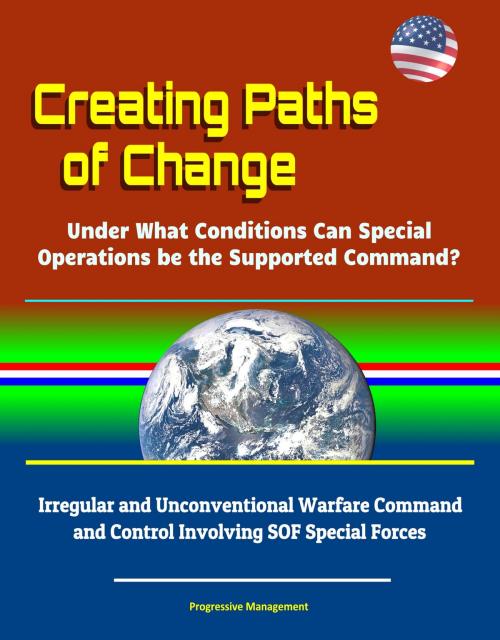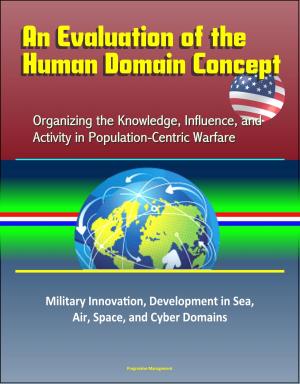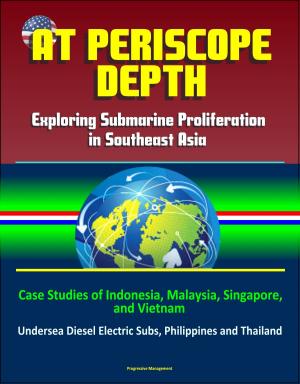Creating Paths of Change: Under What Conditions Can Special Operations be the Supported Command? Irregular and Unconventional Warfare Command and Control Involving SOF Special Forces
Nonfiction, History, Military, Strategy| Author: | Progressive Management | ISBN: | 9780463695739 |
| Publisher: | Progressive Management | Publication: | June 7, 2018 |
| Imprint: | Smashwords Edition | Language: | English |
| Author: | Progressive Management |
| ISBN: | 9780463695739 |
| Publisher: | Progressive Management |
| Publication: | June 7, 2018 |
| Imprint: | Smashwords Edition |
| Language: | English |
This excellent 2018 report has been professionally converted for accurate flowing-text e-book format reproduction.
This study focuses on command and control for irregular warfare operations and the organizational design elements that determine when special operations forces (SOF) can be a supported command. The complexities, uncertainty, speed, and need for interoperability in the 21st-century operational environment require flexible organizations capable of integrating across U.S. governmental agencies. Integration and organizational flexibility are fundamental to conventional forces—but what about their interdependence with SOF to achieve maximum effects?
Militaries have long been uniting conventional and irregular forces. Since the Revolutionary War, U.S. conventional and irregular forces have fought side by side. Throughout each conflict, SOF have performed a supporting role.
The conditions on today's battlefields are much more decentralized and much less simple. The environment is unstable, with U.S. and enemy forces conducting asymmetrical warfare. Insurgencies have required fighting unconventionally. Additionally, information flows can cause friction that further destabilizes the environment. The argument is not that conventional forces cannot adapt to a dynamic operational environment—only that their organizational structure is less effective in an uncertain or complex environment. Dynamic, unpredictable environments call for an organic, decentralized structure. Insights from organizational theory suggest SOF units can be the supported command in these conditions.
I. INTRODUCTION * A. THESIS QUESTION * B. RESEARCH AND SCOPE * C. CHAPTER OVERVIEW * D. METHODOLOGY * 1. Performance within the General Environment * 2. Structural Configuration * 3. Galbraith Star Model * 4. Projected Results * II. CURRENT OPERATING ENVIRONMENT * III. CASE STUDIES * A. SPECIAL ACTIONS FORCES (SAF) 1963-1972 * 1. Introduction * 2. Background (1953-1962) * 3. Analysis * 4. Conclusion * B. AFGHANISTAN VILLAGE STABILITY OPERATIONS * C. TASK FORCE VIKING * 1. Introduction * 2. Background * 3. Analysis * 4. Conclusion * IV. ANALYSIS AND RECOMMENDATIONS * A. FUTURE CONFLICT TRENDS * B. AN OPPORTUNITY FOR CHANGE * C. CONCLUSION * APPENDIX. GLOSSARY OF ORGANIZATIONAL DESIGN TERMS
This excellent 2018 report has been professionally converted for accurate flowing-text e-book format reproduction.
This study focuses on command and control for irregular warfare operations and the organizational design elements that determine when special operations forces (SOF) can be a supported command. The complexities, uncertainty, speed, and need for interoperability in the 21st-century operational environment require flexible organizations capable of integrating across U.S. governmental agencies. Integration and organizational flexibility are fundamental to conventional forces—but what about their interdependence with SOF to achieve maximum effects?
Militaries have long been uniting conventional and irregular forces. Since the Revolutionary War, U.S. conventional and irregular forces have fought side by side. Throughout each conflict, SOF have performed a supporting role.
The conditions on today's battlefields are much more decentralized and much less simple. The environment is unstable, with U.S. and enemy forces conducting asymmetrical warfare. Insurgencies have required fighting unconventionally. Additionally, information flows can cause friction that further destabilizes the environment. The argument is not that conventional forces cannot adapt to a dynamic operational environment—only that their organizational structure is less effective in an uncertain or complex environment. Dynamic, unpredictable environments call for an organic, decentralized structure. Insights from organizational theory suggest SOF units can be the supported command in these conditions.
I. INTRODUCTION * A. THESIS QUESTION * B. RESEARCH AND SCOPE * C. CHAPTER OVERVIEW * D. METHODOLOGY * 1. Performance within the General Environment * 2. Structural Configuration * 3. Galbraith Star Model * 4. Projected Results * II. CURRENT OPERATING ENVIRONMENT * III. CASE STUDIES * A. SPECIAL ACTIONS FORCES (SAF) 1963-1972 * 1. Introduction * 2. Background (1953-1962) * 3. Analysis * 4. Conclusion * B. AFGHANISTAN VILLAGE STABILITY OPERATIONS * C. TASK FORCE VIKING * 1. Introduction * 2. Background * 3. Analysis * 4. Conclusion * IV. ANALYSIS AND RECOMMENDATIONS * A. FUTURE CONFLICT TRENDS * B. AN OPPORTUNITY FOR CHANGE * C. CONCLUSION * APPENDIX. GLOSSARY OF ORGANIZATIONAL DESIGN TERMS















